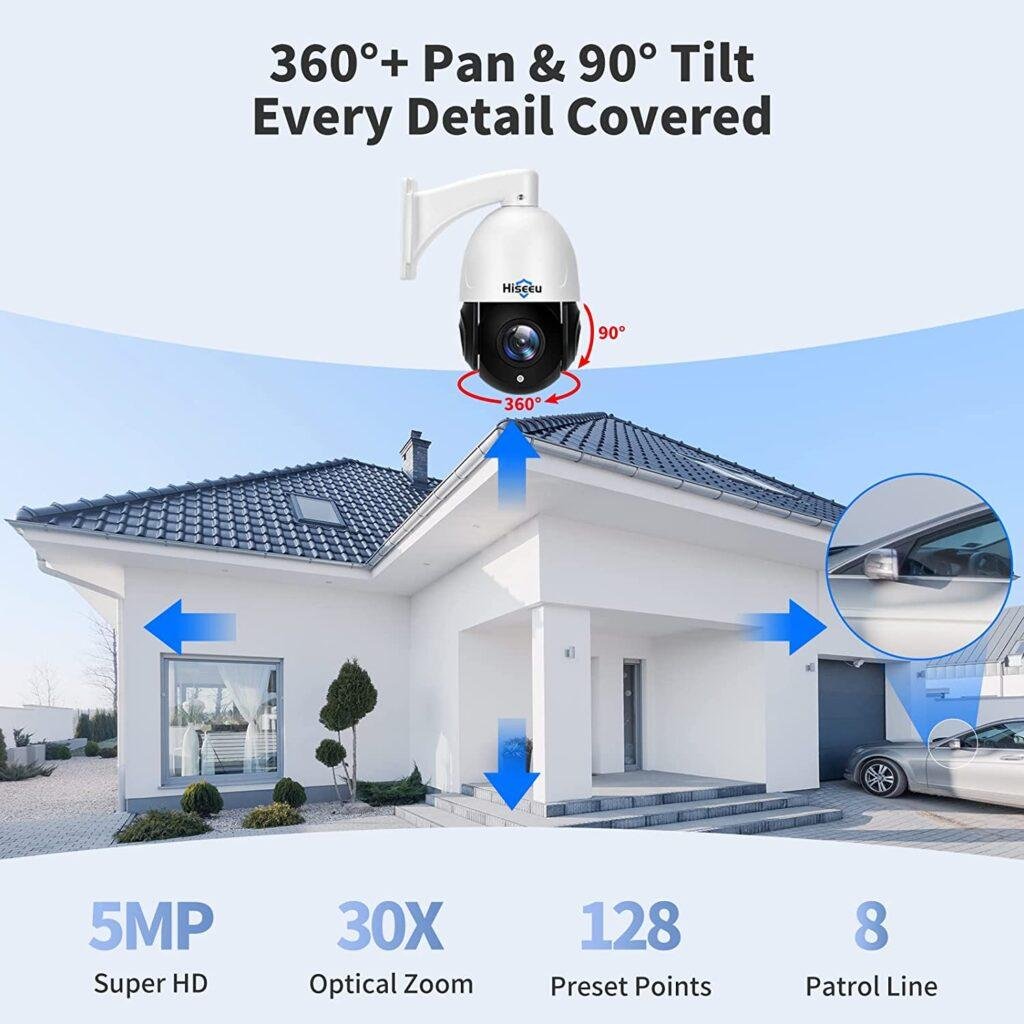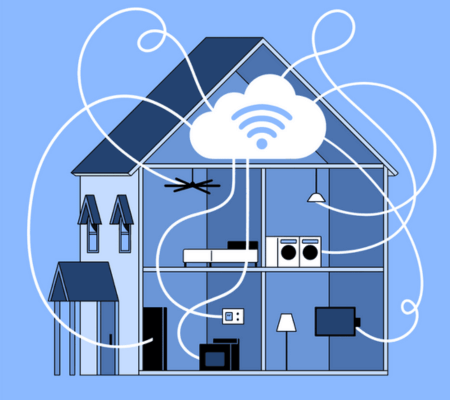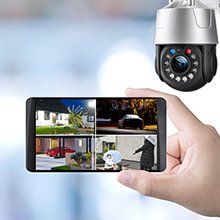Types of surveillance technology for security video surveillance are becoming more high-tech and multi-functional. The high resolution of HD cameras, Full HD, and even Ultra HD is no longer something extraordinary. ASMAG’s Top 10 Professional Surveillance Cameras 2015 highlights consumer interest in cameras with wide viewing angles and high image clarity.

However, in 2016, experts are betting on the development of high-tech products such as HD video surveillance systems, H.265 format, 360- and 180-degree surveillance cameras, and IP systems.
Marketing Research and Expert Opinions
In general, experts and analysts predict strong growth in the CCTV camera market, despite lower prices for certain equipment items and tangible competition from China for all global manufacturers.
Related: Best PTZ Security Camera with Auto Motion Tracking
“I believe the improvement in surveillance cameras has had a big impact on the security industry, especially this year. The cost of complex megapixel cameras has dropped dramatically as this functionality is now available on chips.
The surveillance camera has gone from innovation in performance and functionality to professionalization.” Commoditization levels the competitive landscape as customers are not willing to pay for additional features that some companies provide as “premium” when the features are available in other companies’ base set. end-user needs tend to be marginalized,” says Eric Fullerton, CEO of Vicon Industries.
Video Surveillance Technologies
First of all, surveillance cameras are distinguished depending on the technology used to build the system. Traditionally, two segments are divided: analog and digital surveillance cameras.
Analog Surveillance Cameras
Analog surveillance cameras include models with a high definition of the transmitted signal (High definition, or HD) and video cameras with lower resolution.
Modern video processing technologies and software functionality allow you to get significant advantages when using high-definition cameras, and the cost of such models is not much different from the cost of analog standard definition or 960H (or Wide D1) camcorders. Therefore, today, when talking about analog surveillance cameras, as a rule, they mean HD video cameras, considering others to be outdated.
The advantages of using analog cameras are the simplicity of building systems, their cost-effectiveness, video signal transmission range, compatibility of devices from different manufacturers, and continuity. Thus, for the modernization of an existing video surveillance system, a phased replacement of some components is sufficient. It is generally accepted that this principle is economical in comparison with the organization of a new system.
In addition, the ability to transmit a signal over a distance of up to 500 meters, without the use of various amplifiers and repeaters, also significantly reduces the total cost of equipment.
Another advantage of analog HD surveillance cameras is the reception of a signal without delays and freezes, which are possible when using IP technologies.
Digital Security Cameras
Digital surveillance cameras can use HD-SDI or IP technology.
HD-SDI (High-Definition Serial Digital Interface) – A digital serial interface for transmitting high-definition video, which came to us from professional broadcast television, allows you to transmit an uncompressed and unpacketized image over an analog cable over a distance of 150–300 meters.
Anpviz 5MP PTZ POE IP Security Dome Camera Outdoor with Mic/Audio Pan/Tilt 20X Optical Zoom 165FT IR Night Vision Speed Dome Surveillance Camera IP66

The simple installation of a system with HD-SDI cameras is completely reminiscent of the creation of an analog video surveillance system and does not require staff training for the installation of new equipment.
Each HD-SDI video camera is connected via its own cable (channel), which eliminates the possibility of a decrease in signal quality or frame rate that may occur due to the load on the computer network to which the IP camera is connected.
The disadvantages of the technology are high requirements for cable quality, limited transmission distance, and, rather, a high cost.
“The unsurpassed quality of the “uncompressed” image could not justify the high cost of the solution, as well as a large number of limiting factors, such as the maximum signal transmission distance, the maximum limit in system resolution equal to 2 MP, the limitation of the maximum number of recorder channels (video recording devices with more than 16 channels, I don’t know), excessive requirements for the performance of recording devices, and the lack of a unified development strategy for the developers of the format,” says Sergey Minevich, technical director of TD DEAN.
Thus, HD-SDI video cameras could not be widely used in the security systems market, giving way to the digital video surveillance segment of IP cameras.
5MP PTZ Security Camera Outdoor 30X Optical Zoom, Ctronics WiFi IP Dome Cameras 492ft IR Night Vision & Color Night Wall & Ceiling Installation Human Detection Auto Tracking Cruise 2-Way Audio IP66
The main advantage of surveillance cameras based on IP technology is the ability to scale the system. First of all, this property is of key importance for large projects. In addition, the IP camera itself is a network device and can function without additional archiving and signal transmission devices.
The disadvantages of an IP video surveillance camera are a short signal transmission distance (without the use of additional devices – only about 100 meters), video signal delays in case of network congestion, and the relatively high cost of equipment.
However, even today manufacturers of IP video cameras are ready to offer models that have a much higher resolution than analog video surveillance cameras. Such solutions are much more beneficial for the use of modern video analytics tools and building security systems in general.
Megapixel cameras
The emergence of high-resolution surveillance cameras has allowed security video surveillance to reach a new level. They successfully cope with such video surveillance tasks as detecting and fixing images of large objects, because the lack of providing the necessary image detail in many cases makes the video surveillance system ineffective.
1 MP Camera Quality
To date, surveillance cameras with a resolution of less than 1 megapixel (1280×720 pixels) are practically not used. Yes, and 1MP video cameras are not particularly popular, although their use for small scenes observed can be fully justified from a technical point of view. In addition, do not forget about reducing the cost of equipment when implementing a project based on CCTV cameras with a resolution of 1MP. And it’s not just the price of the camera itself – the required number of hard drives is reduced, subject to the condition of the archive depth being unchanged, and the load on the local network is also reduced, which leads to a decrease in the cost of switching equipment.
2 MP Camera Quality
The resolution of a digital video surveillance camera of 2 megapixels is considered standard for solving the most common tasks of security video monitoring. This resolution can be provided by both IP cameras and HD cameras, usually, it is 1920×1080 pixels.
In the case of upgrading an existing system, to ensure the necessary effectiveness of security video surveillance, it is often enough to install several 2-megapixel digital cameras at key points that require special detail, without completely changing all the equipment. For example, at the cash desk, reception desk, the gate through which vehicles enter, etc. The high-quality image received from the megapixel surveillance camera, if necessary, will help to identify the intruder and will make it possible to recognize the registration number of the car.
3 MP Camera Quality
A resolution of 3 megapixels, or 2048×1536 pixels, is today capable of providing network cameras. Manufacturers of analog HD cameras are actively working to increase the resolution of their equipment to 3MP.
Hiseeu 5MP 30X PoE PTZ Security Camera, 30X Optical Zoom IP Outdoor Camera, 2-Way Audio,500ft Day/Night Vision, Human Detection, IP67 Waterproof, PoE+ High-Speed Dome Camera Work with Hiseeu PoE System

Such devices are designed to solve the following tasks:
Overview of large areas, detailing small objects in the surveillance area through digital image magnification, which makes it possible to identify people, car numbers, etc. And remote access to video data in real-time or to the archive of video recordings.
This ensures the efficiency of using 3-megapixel IP surveillance cameras in security systems of large facilities: car parks and banking institutions, production workshops and stadiums, city squares and strategic facilities, etc.
A 3-megapixel video stream broadcast by an IP camera is compressed by one of the compression codecs (MJPEG, MPEG-4, H.264), which makes it possible to reduce the amount of video data tenfold.
At facilities where high image detail is required at 1-2 key points, it is possible to create a video surveillance system that combines analog and IP cameras. To record information, hybrid video recorders are used.
However, 3 megapixels is no longer the highest resolution of modern network cameras. Manufacturers are ready to offer the market cameras with a resolution of 5 megapixels, 10 megapixels, or 20 megapixels. One of the most popular new CCTV camera formats is 8-megapixel Ultra HD aka 4K.
General Information Sensor Types
The type and quality of the sensing element determine the main parameters of the surveillance camera, such as resolution, sensitivity, dynamic range, signal-to-noise ratio, and IR sensitivity. Currently, surveillance cameras with CCD (or CCD) matrices, CMOS matrices, PIXIM matrices, and thermal imagers are on the market.
A CCD (Charge-Coupled Device, CCD) is currently the most common sensing element for surveillance cameras. CCD matrices are more sensitive than others but have a slower imaging speed and higher cost.
CMOS matrix (complementary metal-oxide-semiconductor, CMOS) allows you to create surveillance cameras that are much more compact. CMOS matrices are more often used in modern IP cameras, which can significantly reduce their cost and ensure optimal imaging speed. The fact that CMOS sensors are not very sensitive is compensated by additional digital features that allow you to get a high-quality picture in low light.
Until recently, the weak point of CMOS cameras was the high level of image noise (due to the difficulty of matching a large number of amplifiers) and low light sensitivity (due to the relatively small area of the light-collecting surface). Now, these problems have been successfully solved by most manufacturers.
A PIXIM sensor is a type of CMOS sensor with separate pixel exposure. Such sensitive elements have a wide dynamic range, so surveillance cameras based on such matrices form a balanced image with good detail and can be used on objects where there are areas with a sharp change in illumination (window or open door) in the frame. Various modifications of PIXIM technology provoke the appearance on the market of matrices with different names, for example, SIMD or WDR.
The thermal imager allows video surveillance in the thermal (infrared) range. The advantage of a thermal imager over traditional CCD and CMOS matrices is that it allows you to see objects in absolute darkness or in bad weather (rain, fog) and gives the operator reliable information about objects in the shade or behind the foliage of trees.
The thermal imager can be built on the basis of an uncooled microbolometric matrix and forms a picture of the temperature distribution, which is seen on the screen by the operator of the observation system.
Colour and Light in CCTV Cameras
To obtain a color image from CCTV cameras, CCD, CMOS, or PIXIM matrices are used, complete with infrared cut-off filters, which bring the spectral characteristic of the image closer to the optimal one for the human eye, increase the resolution of the surveillance camera and improve the signal-to-noise ratio. However, when using IR filters, some light loss is unavoidable.
Black-and-white video cameras for security systems are produced based on black-and-white CCD matrices. In this case, the IR filter is usually absent, because. for a monochrome image, the influence of IR waves on the spectral characteristic is not critical. Also in black-and-white surveillance cameras, there is no mosaic filter. Because of this, black-and-white camcorders are more sensitive than color camcorders.
The light sensitivity of the camera is measured in lux. The more light on the object, the better the image: to obtain a good image quality, as a rule, the illumination of the object is at least 200 lux. In low light, focusing will be difficult and the image will be noisy and/or dark.
The lower the lux value specified in the specifications of the camcorder, the higher its sensitivity to light. As a rule, to observe an object in low light conditions or at night, cameras are used by switching between Day and Night modes (color and black and white, respectively) at a certain level of illumination, which allows for increasing the sensitivity of the video camera.
The following technologies are used to form a “night” black and white image in cameras for security video surveillance.
Easy Day/Night
The video camera is created based on a color matrix with a fixed IR filter. When the illumination decreases to the threshold value, a black-and-white signal is formed by adding the brightness components along with the R, G, and B channels.
The camera’s sensitivity becomes slightly higher. But even in low light, such a surveillance camera is not effective, since it does not have sensitivity in the IR range. Also, it cannot be used with IR illumination.
Switchable IR filter
A day/night surveillance camera can use a color matrix as a sensitive element, but the IR filter installed in front of it automatically shifts when switching to black-and-white mode. Due to this, light losses are reduced, and, as a result, sensitivity is increased.
In addition, the absence of an IR filter makes it possible to use a video surveillance camera complete with IR illumination.
Dual Sensor Surveillance Camera
In dual-sensor surveillance cameras, a color matrix is used in day mode, and black and white in night mode. Switching matrices are carried out automatically when a certain level of illumination is reached.
Due to the absence of a mosaic filter on the black-and-white matrix, additional light losses are eliminated: The surveillance camera has a higher sensitivity at night and demonstrates good image quality during the day.
To improve image quality in low light conditions, as a rule, surveillance cameras with IR illumination are used.
Classification of cameras by application environment
When choosing a CCTV camera, you should consider whether it can be used indoors or outdoors.
Video cameras for installation indoors do not withstand low temperatures and have moisture-permeable housing. At the same time, the cost of internal surveillance cameras is lower than that of video cameras with a higher protection class. It is quite popular to use the built-in IR illumination to monitor the room in low light conditions.
Surveillance cameras for unheated premises have a wider operating temperature range. Many can be operated even at low temperatures. The body of the camcorder is protected from high humidity, and sometimes even from direct water ingress. Some manufacturers position such CCTV cameras as outdoor ones. But in fact, they can work outdoors only in mild climatic conditions.
In the US climate with sharp temperature changes and winter frosts, outdoor installations require specialized outdoor video surveillance cameras.
Classification of cameras by body type
Surveillance cameras on the market for security systems can be made in various housing or not have housing at all.
Modular (unframed) surveillance cameras
Modular surveillance cameras are structurally printed circuit boards with a lens installed on them or a seat for them. There are single-board, double-board, and multi-board frameless video cameras.
Electronic boards in double-board and multi-board cameras can be installed perpendicularly, in parallel, in a “sandwich” type. Additional boards are usually designed to increase the functionality of the device by installing additional electronic components (for example, a microphone or a coprocessor for color modular cameras with additional options).
Technical characteristics of frameless cameras are practically no different from those of models with a case. However, its absence makes it possible to effectively use modular video cameras for covert surveillance of an object. Quite often, they use the installation in the housings of security detectors to obtain an additional video channel. However, hidden video surveillance using a frameless camera can be implemented by installing it on any other device or piece of furniture. All you need is a hole for the lens, which will be quite tiny if you use a pinhole lens.
In addition, modular cameras can be used to create equipment that is unique in its parameters and capabilities and perfectly matches the requirements of a particular video surveillance system. To do this, you will need to pick up a frameless camera, lens, housing thermal housing, and other necessary components.
It happens that such an assembly is justified both from the technical and economic sides. However, a wide range of case surveillance cameras, an abundance of additional functions offered by their manufacturer, and ease of installation are increasingly tipping the choice in favor of ready-made devices.
Box and dome CCTV cameras
Case video surveillance cameras can be both in a standard rectangular case and in a dome version. Dome surveillance cameras, enclosed in a hemispherical housing, are becoming increasingly popular, because. due to their streamlined shape, they have better protection from external factors (for example, dust). Do not forget about the availability of models with a higher protection class – anti-vandal dome cameras.
Types of Surveillance Technology
Vandal-resistant dome cameras are usually installed at facilities with a high probability of mechanical damage to the camera (in schools, railway stations, municipal institutions, and at the entrances of residential buildings). Quite often, outdoor video surveillance systems are created on the basis of anti-vandal dome cameras.
In addition, the design of dome cameras allows them to unobtrusively fit into the interior of almost any room. Dome cameras are easy to mount on the ceiling, but can also be mounted on the wall with the appropriate mounts.
Miniature surveillance cameras have a cylindrical or cubic body. Cylindrical mini-cameras usually have a bracket with a ball joint mounted in a threaded hole at the end of the body. Cubic mini cameras – a square body with a U-shaped bracket.
Miniature video cameras are most often used in installations where installation space is limited, or in objects where a surveillance camera should attract the least attention (for example, museums and other historical sites).
Video eyes are distinguished into separate segments of video surveillance cameras. The video peephole is installed in the door in place of the usual door peephole, and in size and shape, it is quite consistent with it. At the same time, the image from such a surveillance camera can be obtained even without approaching the door: on a computer or on a smartphone.
Video eyes of various models can work both by a motion sensor (when someone is near the door) and only after pressing the doorbell. It is possible not only to monitor the image but also to record events outside the door. Also, modern models of video eyes can send photos of visitors to the smartphone of the owner of the device.
PTZ surveillance cameras
Rotary surveillance cameras (PTZ cameras), installed indoors or outdoors, allow video surveillance of large spaces and crowded places. For example, PTZ cameras are convenient to use in parking lots, supermarkets, schools, warehouses, checkpoints, and especially important facilities.
PTZ camera (Pan-panorama/Tilt-tilt/Zoom-zoom), involves remote control of the direction of view and image magnification. To perform the latter PTZ function, PTZ cameras are equipped with zoom lenses, and the camera zoom ratio is the sum of optical and digital zoom. However, the key parameter is the optical zoom (from x10 to x36).
Thus, the PTZ camera has practically no “blind” observation zones since it can rotate the lens and fix what is happening around automatically, or at the command from the operator’s control panel. The rotary function allows you to reduce the number of surveillance cameras on the site without reducing the viewing area.
Classification of high-speed PTZ cameras
PTZ cameras are usually classified by speed into medium-speed (from 9 to 36º/s) and high-speed (from 120 to 400º/s). If the project provides for the rotation of the camera on an alarm signal and the presence of a large number of presets, it is recommended to use a high-speed one.
For a high-speed PTZ surveillance camera, you can program several dozen presets, as well as set auto patrol routes with an object approaching at certain points or when alarm events occur. Otherwise, PTZ cameras can be in both standard and dome housings; outdoor or indoor installation.
An alternative to PTZ cameras
The disadvantage of PTZ cameras is the lack of full coverage of the object: the video camera may turn to the side of the alarm event and not record it. Modern high-definition surveillance cameras allow you to get good video quality even when observing large scenes. Therefore, PTZ cameras are being replaced by panoramic surveillance with video cameras with a fish eye lens.
- How Does An IP Camera Work?
- High-Quality Netatmo Smart Indoor Camera Review
- How to choose an IP camera
- 10 Best 4K PTZ Security Camera
- Ring Indoor Cam As Baby Monitor
FAQs about Surveillance Technology
1. What are the examples of surveillance technology?
- Closed-Circuit Television (CCTV): CCTV cameras are commonly used for monitoring public spaces, businesses, and homes.
- Drones: Drones equipped with cameras are used for aerial surveillance, including monitoring remote areas.
- GPS Tracking: GPS technology allows tracking the location of vehicles, individuals, or objects in real-time.
- Facial Recognition: Facial recognition software is employed to identify and track individuals based on their facial features.
- Biometric Surveillance: This includes fingerprint and iris scanning for identity verification.
- Internet of Things (IoT) Devices: Smart devices like security cameras, doorbells, and sensors can provide surveillance capabilities.
- Social Media Monitoring: Some companies and organizations use software to monitor social media activity for security and marketing purposes.
2. Why is surveillance technology important?
- Security: Surveillance technology helps deter and detect criminal activities, ensuring public safety and property protection.
- Crime Prevention: The presence of surveillance cameras can discourage potential criminals from engaging in illegal activities.
- Evidence Gathering: Surveillance footage can serve as crucial evidence in criminal investigations and legal proceedings.
- Traffic Management: Surveillance assists in traffic control, accident detection, and congestion management.
- Business Efficiency: Surveillance can improve workplace safety, employee productivity, and customer service.
- National Security: Governments use surveillance technology to monitor borders, identify security threats, and protect their citizens.
3. What is surveillance and how does it work?
- Surveillance refers to the systematic monitoring of activities, behaviors, or information for the purpose of control, management, or protection.
- How it works: Surveillance technology collects data through various means such as cameras, sensors, or data tracking devices. This data is then processed, analyzed, and often stored for future reference or action. The information gathered is used for security, monitoring, or decision-making purposes.
4. What is the basic concept of surveillance?
- The basic concept of surveillance revolves around the continuous observation and collection of data about individuals, objects, or areas. This data can be visual, auditory, or digital and is typically used to maintain security, enforce laws, or manage resources effectively. Surveillance can be both overt, where the subject is aware of it (e.g., security cameras in a store), or covert, where it’s concealed (e.g., undercover police operations).
- Purpose: Surveillance aims to gather information, prevent or respond to incidents, and ensure the safety and well-being of individuals, organizations, or nations while respecting privacy and ethical considerations.












